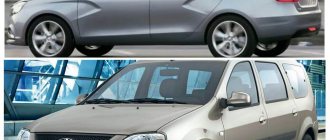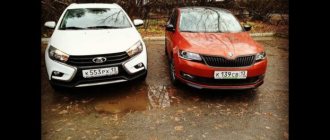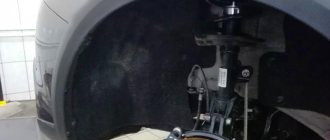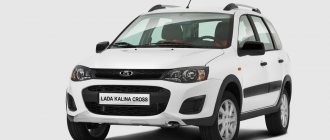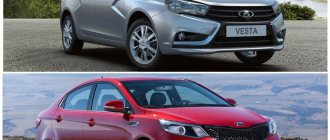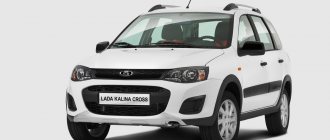08 August 2016
At the present time, when the crisis is still current news and reality for most people, there is a natural desire to save money on purchasing a car. More and more people are paying attention to budget options for transportation. These are the LADA brand cars, and among them the Vesta and Kalina models hold the leading positions in terms of sales. And a logical question arises, which is better Lada Vesta or Kalina Cross?
1. Geometric cross-country ability of Lada Vesta and Kalina Cross
— a set of parameters that affect the ability to move unhindered in rough terrain. Such parameters include ground clearance, departure and approach angles, ramp angle, and overhang size.
Ground clearance declared by the manufacturer: 183 and 178 - a difference of 5 mm in favor of the Cross, it would seem bullshit.
Dimensions of the car from the official Lada website in pictures:
As we can see from them, the Cross is both shorter and narrower, and the base length is shorter, and the overhangs are also smaller. But especially the total superiority in the base - 16 cm!!
We took measurements on the bumper; there is no way to measure protection for our collective farm test.
255 mm in front along the lower edge of the Cross' bumper covered with an overlay.
Vesta has almost the same 250 mm to the painted bumper. The angle seems higher, so it may be a little smaller - but in general this is not important, anyway, this was not done on calibrated surfaces, no one checked the pressure in the wheels, and so on. The main thing is to understand the order of numbers.
Let's go further - we measured the distance from the wheel to the bumper.
Cross:
Apparently Vesta is still a little lower:
Next we moved on to more complex, and probably less accurate measurements: we took the center of the tire under the bumper and, using the handle of a shovel, which was along the edge of the bumper, took the distance.
Cross:
Vesta:
11 centimeters of just the length of the front bumper is a lot for geometric cross-country ability, Vesta is a minus.
We go to the sills, measure in the area of the B-pillar - the Cross sills are covered with practical unpainted plastic.
Vesta’s is different - the power element of the bottom is painted and it is lower.
Cross rear overhang:
The rear overhang of Vesta is 6 cm longer:
Under the rear bumper of the Cross they measured as much as 38 cm, again, unpainted plastic and a trim that can be changed separately. But the most important thing is that the distance to the rear beam is very large and along its entire length it is almost straight, and the spare wheel niche and muffler are high and do not stick out.
On Vesta it is smaller (34 cm), but the main problem is that the beam is lower, and the spring cups protrude much lower than it itself - on hard things it can be damaged. The muffler also protrudes more strongly and is located lower, then Vesta demonstrated this by cutting off a hillock with the muffler, where Cross passed without noticing.
We waited for everyone while we shamanized with the roulette, the Tuareg especially warmed the soul if something went wrong))
Interior equipment of Kalina Cross
The manufacturer claims that the Kalina in the Cross modification should be classified as a crossover, which makes it different from the regular version. People knowledgeable about this issue confidently express their disagreement with this interpretation. To resolve a controversial situation, many experts are inclined to take a test drive. In our case, a specimen equipped with a 16-valve engine and automatic transmission was chosen for testing.
The first thing we immediately pay attention to is the extraordinary design of the body and interior, what distinguishes the Cross from a simple model. Inside, the bright tones of the upholstery hint at its appeal. The feeling of the seats is much more pleasant compared to the usual Kalina variation. The upholstery of the pillow and side support bolsters is dense, and the driver's seating position is higher. We continue to find out which is better of the two models Kalina or Kalina Cross.
The “cross” version of AvtoVAZ’s brainchild has 3 mm more ground clearance, which differs from its predecessor. Standard tires can also add clearance. The total is an increase of 7 mm. The manufacturer claims a total increase in height of 16 mm. Note that the springs in the shock absorber struts remained unchanged, only the support cups of the side members were shifted to the sides by 16 mm. Obviously, Kalina or Kalina Cross is better from the VAZ brainchildren.
Is Kalina-2 good?
What do you like about a car worth 7 thousand conventional units? It warms up well in winter, the stove is simply thermonuclear! A weak air conditioner that does its job, but is not available in all trim levels. On top of the “dashboard” there is a convenient drawer with a lid.
There is a place for a mobile phone if the radio is simple without a screen. And that's what she is. The plastic is cheap and hard, but for the money it's ok. Essentially, what is soft plastic for? Why not lie on it?! There are no big complaints about the car.
There are several minor shortcomings. The knee sometimes rests against the console, sometimes causing bruises. It depends on the driver's build, but it's fine for me. The steering column switches are Soviet, they work a little noisily, but do not break. Convenient hazard warning button, illuminated glove compartment, making it easy to find something in it in the dark.
Now opinions about the ordinary Kalina
- Good fuel efficiency, if you compare: in the city no more than 7 liters, and on the highway you can “keep within” 5 liters.
- The car is suitable for repair in non-specialized service stations. No matter what breaks, spare parts will be found immediately.
- The station wagon moved to Kalina from Lanos. The interior of the car from AvtoVAZ turned out to be warmer and warms up faster in winter.
- The suspension is noisy, which is especially noticeable on a textured surface.
- There is enough space in the cabin, although looking at the body from the outside you wouldn’t say so.
- The finishing of the panels in the interior is characterized by cheap plastic.
- Maneuverable car. Among the shortcomings of the interior is poor ventilation of the front windows.
- If the car is loaded, then when driving uphill in 4th gear there is not enough engine torque.
- I have ridden 50 thousand km without any complaints. Now the interior is beginning to manifest itself with squeaks and other unpleasant noises.
Offer for sale
No offers from car dealerships
New cars on AUTO.RIA
Cookies “For the convenience of using the site and all services, we use cookies.
To learn about types of cookies
and configure them,
click "Customize" or check out
"Cookie Policy"
.
I accept all settings
Cookie settings “We (ARS ONLINE OÜ) use cookies that are required for the operation of our website and services, based on legitimate interest. Also, with your consent, we would like to install optional analytical cookies on your device to remember data about browsing and use of services, as well as marketing cookies that will help us understand which services and products interest users most.
By turning on these cookies, you help improve our services and products. Read more about cookies in our Cookies Policy. We install mandatory cookies in any case. Below you can choose whether or not to allow us to install optional cookies."
Save
Controllability
Handling has become better. Thanks to the steering rack, it has become shorter, and the steering wheel can now be turned from one stop to another in just 3 turns, and not 4, as before. The steering wheel itself in the new car is also attached differently. Due to all this, the sensitivity of control and the rigidity of the steering system have increased. The car reacts faster to the driver’s actions, and it has become easier to avoid obstacles and bumps on the roadway.
In addition, one cannot help but pay attention to the car’s new anti-lock braking system, which in the “luxury” configuration is also supplemented with a stabilization program. The design of the brake system has changed somewhat - some of the parts are now imported.
Lada Granta Cross: what is better than the previous Kalina Cross?
Having transformed from Kalina to Granta, the station wagon with the Cross prefix has changed a lot in appearance. But that’s not the main thing!
With this station wagon, AvtoVAZ formally completes the reform of the Granta family. However, you can only partially call the car new. Its complex physiognomy, borrowed from Vesta, was shown to us last fall, and was tried on by Kalina Cross almost five years ago
Exterior
Initially, Lada Kalina was considered exclusively as a “workhorse”. Consequently, the attitude towards design was largely characterized by the residual principle. They say that this is not the main thing for such a machine. But after the restyling, the model began to look much more lively and aggressive.
Initially, the Lada Kalina was a simple car. Rather, even too simple.
The front bumper is decorated with a huge air intake supporting a small radiator grille. And under the spectacular headlights there are small foglights located in massive seats.
The new Kalina looks much more interesting from the front!
However, there are an order of magnitude fewer changes in the profile. The same modest and proportional doors, a round tank flap with a recess for opening, front fenders and so on. Perhaps the changes affected only the rims and rear fenders.
On the side, other than the different rear wings and rims, no changes are observed.
The situation is similar with regard to the stern. There are no fundamental changes observed, with the exception of the rear bumper, which has become more massive and powerful, and has also acquired new reflectors and a trim at the bottom.
At the rear, the changes are more noticeable, but they are not fundamental.
The image of Lada Vesta is fundamentally different. She was not a nondescript machine, to which they later tried to instill pseudo-aggressive features. Initially, Lada Vesta was created as a landmark and expressive car - the first representative of AvtoVAZ’s new corporate style. That’s why it looks more harmonious – the headlights, chrome, air intake, foglights, “X” lines and other elements of the front end combine perfectly.
Vesta's front end is much more harmonious.
From the side the impression is the same. A solid, complete product, with logical lines and transitions, stylish rims and considerable ground clearance.
The ground clearance of the Lada Vesta can be the envy of some crossovers.
And the food didn’t disappoint. The chopped lines of the stops are impressive, especially against the background of a modest bumper and a proportional trunk lid, decorated with large letters of the brand name.
Vesta looks great from behind!
Service cost
Lada Vesta service
After fifteen thousand kilometers, the time for the first maintenance will come for the Lada Vesta. At an official dealer, the price for this procedure will be 3,500-5,000 rubles, depending on the region where the service will take place. Another important procedure that awaits the car owner every year is changing summer tires to winter ones. It all depends on how much a person is willing to spend. For example, Bridgestone tires model BLIZZAK SPIKE 01, which have better grip on icy roads thanks to studs with a cross-shaped notch in the middle. On snowy roads, excellent traction is achieved with the help of widened intersections, which are equipped with cross grooves. The price of such tires starts at 3150 rubles.
Kama tires of the EURO 519 model can be a good budget purchase.
Its main advantages are:
- Lamels made in the form of a fan;
- V-shaped grooves;
They provide a sufficient level of self-cleaning. The spikes are firmly fixed on the dense bottom layer, and the top layer remains soft, thanks to the high percentage of natural rubber. The price for Kama starts at 1,700 rubles.
Maintenance of Lada Kalina Cross
As in the case of the new product, TO-1 Lada Kalina Cross at dealers after fifteen thousand kilometers traveled will cost 3,500-5,000 rubles, depending on the region in which the service will take place, by the way, this is slightly cheaper than servicing a Kia Rio. Prices for winter tires from both domestic and foreign manufacturers for the Lada Kalina Cross are almost the same.
For example, the popular Nordman 5 tire model from the Finnish company Nokian, which provides decent grip on icy and snowy roads, starts at a price of 2,700 rubles. And the domestic manufacturer Kama offers at least two thousand per tire for its model 505.
Advantages and disadvantages
Among the advantages of Kalina 2, both testers and new car owners primarily highlight the original design. For decades, it was believed that beautiful cars are made only abroad, and the Russian auto industry lagged behind in this regard by at least 10–15 years, but now everything is not so clear.
It is worth noting the increased engine power and a different quality of the dashboard with a more convenient location of sensors and scales. An airbag is now even included as standard. The reliable suspension now has an increased service life and the front struts are now much more durable than those of most other domestic cars.
Now about the disadvantages of the new Kalina 2. The disadvantages include, first of all, the too noisy and already quite outdated eight-valve engine (in the “standard” configuration), then the hydraulic adjustment of the headlights (other cars have only had electric adjustment for a long time) and the lack on the dashboard sensor indicating the coolant temperature.
In addition, unfortunately, the quality of the Russian assembly is still “lame” - some small parts may be screwed carelessly or not tightly enough, and in some examples of the car you can hear the doors squeaking against the body while driving.
Advantages and disadvantages of Vesta
Lada Vesta car However, Vesta is a pretty good car, which has a number of advantages over Kalina. Firstly, this is a more spacious Lada:
| Vesta | Kalina |
| Length 4410 mm | Length 4104 mm |
| Width 1764 mm | Width 1700 mm |
| Height 1497 mm | Height 1560 mm |
| Ground clearance 178 | Ground clearance 160 |
In addition to the differences in the dimensions of the car, when purchasing Vesta you get:
- Original modern appearance. Which stands out for its species among its classmates;
- Comfortable and cozy interior with modern equipment and the necessary set of accessories;
- Spacious trunk;
- Dynamic, economical and safe car.
Driving such a car is a pleasure, and its expressive appearance adds charisma to its owner. The only advantage of the Lada Kalina is its lower cost. But not everything is good in Vesta, there are disadvantages:
- The brake pedal is higher than the gas pedal, everyone is used to them being at the same level;
- The display and radio are not recessed into the front panel, which leads to the screen being exposed to bright light and the readings are difficult to read;
- More than strange control of the on-board computer. But you get used to it pretty quickly.
On YouTube, follow the link to see a comparison of two Lada cars.
Specifications
Engines
Now the Lada Vesta is offered with only one engine, but this meager line will be expanded over time and there will be four engines. Kalina is equipped with three engines.
The Lada Vesta is equipped with a 106-horsepower, injection domestic power unit. At around 5,800 rpm it produces maximum output, and its peak thrust, which reaches 148 Nm, occurs at 4,200 rpm. With it, Vesta accelerates to hundreds in 11.8 seconds, giving a maximum of 178 km/h. It is noteworthy that this engine is the top one for the Lada Kalina, and no changes are made to it. However, the hatchback with it is more dynamic than the Vesta - changing hundreds on it takes 11 seconds, and the maximum speed is 3 km/h more (181 km/h). With automatic transmissions the situation is somewhat different. In this case, Vesta has, albeit a small, advantage in both respects - acceleration in 12.5 seconds. versus 12.9 sec. and a peak speed of 178 km/h versus 175 km/h.
The 106-horsepower Russian engine is installed on both Vesta and Kalina.
Another Lada Kalina engine is a 98-horsepower, 1.6-liter unit. To get all l. With. it needs to be revved up to 5,600 rpm, and at 4,000 rpm the engine produces its greatest thrust of 145 Nm of torque. A special feature of the configuration is that the power unit is combined exclusively with an automatic transmission, which affects the dynamics of the car - Kalina manages to reach a hundred in only 13.8 seconds, with a top speed of 171 km/h.
Kalina's 98-horsepower 16-valve engine is coupled exclusively with automatic transmission.
The third, and weakest, Lada Kalina engine is an 87-horsepower, 8-valve unit. This is a budget version of the model. Its power is small and achievable at 5,100 rpm, but the torque is quite decent and reaches 140 Nm at 3,800 rpm. Dynamic characteristics are not great, but 12.2 sec. for a set of hundreds at 168 km/h maximum do not look so bad. The same engine is planned to be installed on the Lada Vesta, which will reduce the price of the sedan and make it even more competitive.
This budget engine produces 87 hp. pp., they intend to install it on the Lada Vesta.
In addition, we can soon expect the appearance under the hood of the Lada Vesta of a 110-horsepower HR16DE-H4M engine, which Alliance Renault Nissan shared with AvtoVAZ, and a 1.8-liter domestic power unit. The latter is the latest development of the Russian concern and is already installed on the X-Ray model, as well as a foreign engine. Soon they will appear under the hood of the Lada Vesta.
Lada Vesta will also receive a motor from the Alliance.
Transmissions
Both models offer three types of gearboxes. However, AvtoVAZ’s approach in this regard is different. The Lada Vesta has a pair of 5-speed manual gearboxes - the French type JH3 510 and the Russian MT type VAZ-2180. It is noteworthy that the latter has been modernized in order to keep up with the foreign checkpoint in terms of accuracy of operation. To do this, the “mechanics” from Priora were taken and seriously redesigned, including the use of a different secondary shaft (reinforced), synchronizers and a switching module from the German brand Schaeffler. And the oil volume has been reduced by 30%. All this had a beneficial effect on the clarity and quality of work, reduced background noise and eliminated other disadvantages of the box.
The mechanical transmission of the Lada Vesta works clearly and smoothly!
The Lada Kalina has only one 5-speed manual transmission - the VAZ-2181 type. In general, it is not bad, but in performance it is inferior to Vesta’s transmissions. The lever vibrates, switching is not so clear, and background noise takes its toll. In general, all the shortcomings that the creators of Vesta struggled with remain.
But Kalina’s gearbox does not have such advantages!
In addition, Vesta and Kalina have the same 5-band robotic gearbox of the AMT-2182 type, created on the basis of a mechanical transmission by adding an electronic control unit and foreign components. In general, it is quite enough for movement. In the city, the shifts are, of course, more noticeable compared to a classic “automatic” with the same number of gears, but the ride turns out to be quite comfortable and convenient. The robot also performs very well on the track. This box is installed on the Lada Vesta in order to reduce the cost, since it is cheaper than an automatic transmission.
The AMT type robot is the same for both models!
But the Lada Kalina has a traditional torque converter type JF414E from the Japanese corporation JATCO. Despite the fact that the automatic transmission is only 4-band, in the city it fully justifies itself, although on the highway the absence of 5th speed is still noticeable.
The Japanese 4-band automatic transmission from JATCO performs well, especially in the city.
Chassis
For the B segment, both cars have a standard suspension layout. The front axle has MacPherson struts, while a torsion beam is mounted at the rear.
The chassis of Kalina and Vesta are structurally identical - beam and MacPherson struts.
However, the settings of the shock absorbers and other components are different, which affects the handling. Lada Vesta in this regard is more collected and understandable. It steers sharper, turns more enthusiastically, rolls less, and there is almost no wave swing. But in Kalina all this is felt to one degree or another.
However, the handling of the Lada Vesta is noticeably better!
What is the price of Kalina and its “cross” version?
The cost of the model has a significant impact on the choice of buyers. The modification we are considering is approximately 30 thousand rubles more expensive than the usual version. Experts tend to believe that this difference is fully justified, since Cross has the following preferences:
- light alloy wheels of increased diameter;
- protective body kit;
- increased ground clearance;
- modified suspension;
- improved exterior.
Compared to the background of the so-called “crossover”, Kalina, which costs about half a million rubles, seems unreasonably expensive. However, one should not discount the availability of such options as:
- automatic transmission;
- "Lux" package;
- systems: stabilization and conditioning.
If you compare them with foreign cars, you will immediately notice that the latter, which have similar options, are priced significantly more expensive.
“Discarding” the issue of price from attention, it can be argued that most buyers will choose Kalina Cross in different bodies, including station wagon, between Kalina or Kalina Cross. This is not surprising, since the modification provides its owner with the following advantages:
- confident maneuverability in different terrain conditions;
- bright and extraordinary appearance;
- decent reliability of suspension elements;
- feeling of drive at high speeds.
If we compare, this performance is a progressive direction and has enviable prospects. When choosing from Kalina 2 or Kalina Cross, many will prefer the new product.
What to buy anyway
Will your purchase be a Vesta or a new Kalina under the fresh name Granta when the car has to be changed? Everyone considers this question for themselves. If you drive mainly around the city, where it is difficult to park, then Kalina is better. If you need a car for long roads, then Vesta will be optimal.
Of course, Vesta looks cooler today, and young people are unlikely to buy Granta if they have the money. It is made at a new technical level, equipped with all possible bells and whistles and functions that some foreign cars do not have. Those who have already bought Kalina drive it and are also happy. After all, it consumes less gasoline. For example, on the highway, consumption during leisurely driving is 5.3 liters per “hundred”.
And if you drive in the city, then Grant and Kalina have no equal in terms of efficiency! You can’t play around too much in a Lada Vesta; as they say, you’ll end up out of the woodwork quickly. In terms of parking space, I think everyone understands which car is better.
In general, everyone has their own choice. For this purpose, the plant produces different types of machines so that you can choose. It all depends on the purpose of the car and the needs of the car owner. Each of the models under consideration has its own pros and cons. There are many owners of both brands who will diligently prove that their car is better than others. And everyone will be right in their own way!
Good day to all readers of my Kalinka!
The question has arisen whether to change Kalina or not. The reason for the hesitation is the condition of the body, namely rust. Repaint with a budget for painting and all spare parts for under 100 k, or exchange for Vesta Cross, Grant station wagon.
I went to the salon today to ask the price. take it for a test drive. The manager at the salon is a good friend of mine, so I got to ride quite a bit. On Vesta Cross drove about 30 km, on Grant about 15-20 km.
So, first things first. The first in line was Vesta Cross with a 1.8 Lux Prestige engine on the mechanics
. Exterior design - 5 points. But, again, it depends on the color. There was no need to force the manager to talk or ask questions, because... I know all these Lada cars like the back of my hand in terms of theory, design, etc. Just general impressions. Handling is awesome, Shumka is also awesome, you can’t feel the speed.
The 1.8 engine doesn't run at all
, nowhere and no way! You can throw tomatoes at me, whatever you want, but I’m not going to refuse these words, because... it is a fact! Just an example. You drive in 4th gear at about 70-80 km/h. You press the gas of a light driver and you don’t feel any acceleration. You press the gas to the floor - nothing changes! No kick, no jerk, no feeling of acceleration. And so on in any mode. Accelerates smoothly. There is no trace of such an explosion as I have on Kalina (21126 stock engine)! It runs somehow only in third gear. 1-2 gears are clearly not for acceleration. We'll talk about this later. The clutch is very light, and therefore there is a complete lack of information content. You don’t feel the moment of starting, you don’t feel the moment of grip when switching, you don’t understand when to release the gas so that there is no over-throttle. Chutos even fried it out of habit. I couldn’t get used to it after 30 km. If I had my car, it would take at least a month to get used to this clutch. But I was pleased with the consumption (not shocked, otherwise everyone writes that it is cosmic) 8.4 liters per 100 km (4 people in the cabin) mixed mode. Gas to the floor not too often.
Features of controlling the Kalina Cross model
Normal driving on a flat road can give the driver a feeling of pleasure. This was made possible thanks to a modified suspension. The characteristic clanking sounds when going over bumps are now a thing of the past, although the regular Kalina is still characterized by extraneous sounds from the chassis, which makes it different from the Cross for the worse.
The only drawback that the manufacturer has to correct is the “humming” standard tires. In both versions of Kalina, the noise of tires on the road surface at speed can quickly cause discomfort to the driver.
During testing, the “Cross” suspension showed its elasticity, as evidenced by the absence of swings. Only some clattering noises were occasionally heard from the stern door. What was it? Perhaps a minor assembly flaw, which is unacceptable for crossovers.
On icy surfaces, the Cross brakes quite loudly. We cannot remain silent about ABS, since the correct configuration of this system allows you to maintain confident control not only when driving uphill, but also when descending from an incline.
Also a good addition to the safety complex was the electronic system responsible for stabilizing movement on slippery surfaces. This is a significant difference between the “cross” performance. The electronics skillfully “restrain” the driver from sudden maneuvers or switching, the purpose of which is to “derail” the car from the given trajectory.
The question of which modification has the best and most predictable behavior when driving in snow no longer requires a detailed answer. Of course Cross! The above modification preferences can quite clearly emphasize all the advantages. When driving in the snow, the stones under its cover are unlikely to be able to harm the body, since its lower perimeter is reliably protected with black plastic linings. If we compare, the regular version of Kalina is not able to cope with snow obstacles so confidently, so once again it loses the championship to Cross.
If we compare it with other models, then this car is quite capable of meeting the basic criteria for models in the budget segment. During slipping, the electronics do not completely “strangle” the engine, thereby giving it a chance to “break through” the “snow captivity” that suddenly appears on the way.
Interior
Compared to the original version, the interior of the Lada Kalina has been significantly redesigned. Gone is the combination of black and beige plastic, the awkward shape of the center console, bloated air vents and uncomfortable ergonomics. They worked much more carefully on the new version of the interior - in the center of the dashboard there is a large display, the arrangement of keys and dial controls has become much more convenient and logical, the dashboard has acquired wells and poisonous green backlighting, the upholstery of the door panels and other interior elements have changed slightly. But the revolution did not happen - only the most obvious defects and shortcomings were eliminated in the model.
The interior of the Lada Kalina is not bad. But there is nothing outstanding about it either.
Lada Vesta is different inside. Her salon is designed in a modern style. Smooth transitions and lines of the dashboard, 3-spoke multi-steering wheel, titanium inserts, high-quality assembly, thoughtful ergonomics, a display that fits organically into the composition, comfortable seats and a spacious back row. This set of advantages is more than enough to adequately compete with the segment leaders, and Kalina Veste is not a rival at all!
The interior of the Lada Vesta is much more attractive and functional.
Let's sum it up
Among Kalina or Kalina Cross, it was Kalina Cross, including the station wagon in our test, when compared, it showed its advantages over the regular variation of the model. If the owner is not embarrassed by the difference in cost and needs a car that is truly balanced in its consumer qualities, then we recommend that you look at this practical product from the domestic giant of the automotive industry.
After the Lada Vesta entered the market, many became convinced that public interest in other AvtoVAZ models would soon fade away altogether. But this is not true, because other cars are produced and sold as before. However, for them the new product has become a powerful competitor, and a considerable number of potential buyers are thinking about the opportunity to save up a little more and purchase a new sedan. A significant part of them initially targeted the Lada Kalina.
Will Kalina become a serious rival to Lada Vesta at a lower price?
So is it worth abandoning the original goal? Or is Vesta not as good as her creators try to make her out to be? In this case, it is necessary to focus specifically on the usual modification of the Lada Kalina. It’s no secret that it also has a couple of sports versions – Kalina Sport and Kalina NFR. But these are “not for everyone” cars, therefore, they will not become widespread.
The price of the Lada Vesta is higher, but the car is definitely better!
Appearance
And finally, the body length has become a little larger. This was possible after increasing the wheelbase, which, in turn, made the similarity with the crossover even more obvious.
The lighting equipment, as well as the radiator grille, remained the same as the previous modifications.
Employees of the Volzhsky Automobile Plant note that they were able to largely eliminate the problem associated with poor noise insulation.
The interior has not undergone any special modifications. By and large, everything remains the same as last year’s version of Kalina. However, there are several innovations:
- ISOFIX fastenings appeared;
- The ability to adjust the seat belt tension has been added.
The interior was enlarged due to the overall enlargement of the body.
It is worth noting that the upholstery is now made from new materials. Moreover, the color palette has been significantly expanded. Thanks to this, car owners have the opportunity to individualize the interior decoration as much as possible.
It is also worth noting that the engineers managed to expand the trunk. Its volume is 350 liters, which is not bad. As a result, the Kalina hatchback, in fact, became the first crossover produced in Russia with such a large luggage compartment.
